ICND2 – OSPF Questions 3
[am4show have=’p2;’]
Premium Member: You can test your knowledge with these questions first via this link.
[/am4show]
Question 1
[am4show have=’p2;’]Refer to the exhibit. The network associate is configuring OSPF on the Core router. All the connections to the branches should be participating in OSPF. The link to the ISP should NOT participate in OSPF and should only be advertised as the default route. What set of commands will properly configure the Core router?
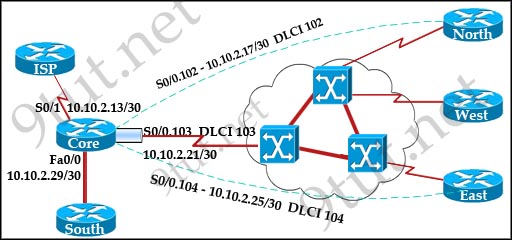
A. Core(config-router)#default-information originate
Core(config-router)#network 10.0.0.0 0.255.255.255 area 0
Core(config-router)#exit
Core(config)#ip route 0.0.0.0 0.0.0.0 10.10.2.14
B. Core(config-router)#default-information originate
Core(config-router)#network 10.10.2.13 0.0.0.242 area 0
Core(config-router)#exit
Core(config)#ip route 0.0.0.0 0.0.0.0 10.10.2.14
C. Core(config-router)#default-information originate
Core(config-router)#network 10.10.2.16 0.0.0.15 area 0
Core(config-router)#exit
Core(config)#ip route 0.0.0.0 0.0.0.0 10.10.2.14
D. Core(config-router)#default-information originate
Core(config-router)#network 10.10.2.32 0.0.0.31 area 0
Core(config-router)#exit
Core(config)#ip route 0.0.0.0 0.0.0.0 10.10.2.14
Answer: C[/am4show]
Explanation
The question states that the link to ISP should not participate in OSPF -> answers A, B are not correct.
In answer D, the “network 10.10.2.32 0.0.0.31 area 0” does not cover the IP address of S0/0.103 (10.10.2.21) -> D is not correct.
The default-information originate command advertises a default route to other routers, telling something like “please send me your unknown traffic”. So in this case, besides a full routing table, other routers will also receive a default route from Core router.
But please notice that Core router needs to have a default route in its routing table. That is why the command “ip route 0.0.0.0 0.0.0.0 10.10.2.14” is added to Core router. By adding the “always” (after “default-information originate” command) the default route will be advertised even if there is no default route in the routing table of router Core.
Question 2
[am4show have=’p2;’]Refer to the exhibit:
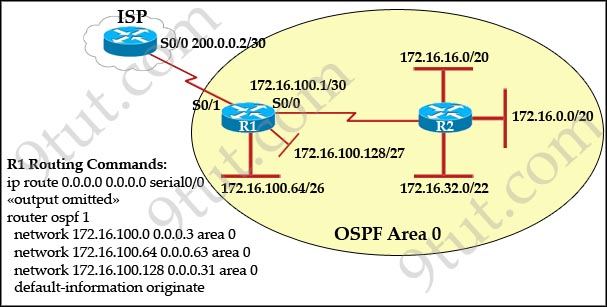
Assume that all of the router interfaces are operational and configured correctly. How will router R2 be affected by the configuration of R1 that is shown in the exhibit?
A. Router R2 will not form a neighbor relationship with R1.
B. Router R2 will obtain a full routing table, including a default route, from R1.
C. R2 will obtain OSPF updates from R1, but will not obtain a default route from R1.
D. R2 will not have a route for the directly connected serial network, but all other directly connected networks will be present, as well as the two networks connected to R1.
Answer: B[/am4show]
Explanation
The default-information originate command advertises a default route to other routers, telling something like “please send me your unknown traffic”. So in this case, besides a full routing table, R2 will also receive a default route from R1 -> B is correct.
Note: But in this question, the static route should be “ip route 0.0.0.0 0.0.0.0 serial0/1″ (not serial0/0), that may cause a routing loop.
Question 3
[am4show have=’p2;’]Refer to the exhibit. Which two statements are true about the loopback address that is configured on RouterB? (Choose two)
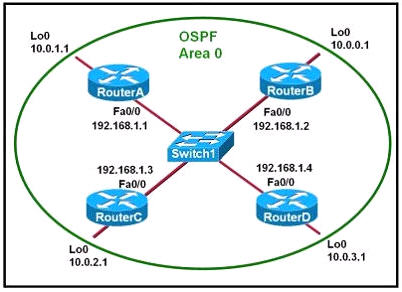
A. It ensures that data will be forwarded by RouterB.
B. It provides stability for the OSPF process on RouterB.
C. It specifies that the router ID for RouterB should be 10.0.0.1.
D. It decreases the metric for routes that are advertised from RouterB.
E. It indicates that RouterB should be elected the DR for the LAN.
Answer: B C[/am4show]
Explanation
A loopback interface never comes down even if the link is broken so it provides stability for the OSPF process (for example we use that loopback interface as the router-id) -> B is correct.
The router-ID is chosen in the order below:
+ The highest IP address assigned to a loopback (logical) interface.
+ If a loopback interface is not defined, the highest IP address of all active router’s physical interfaces will be chosen.
-> The loopback interface will be chosen as the router ID of RouterB -> C is correct.
Question 4
[am4show have=’p2;’]Refer to the exhibit.
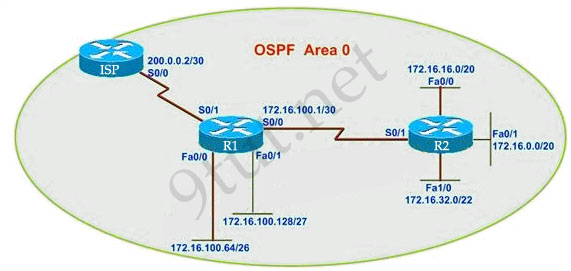
R1 routing commands:
ip route 0.0.0.0 0.0.0.0 serial0/0
router ospf 1
network 172.16.100.0 0.0.0.3 area 0
network 172.16.100.64 0.0.0.63 area 0
network 172.16.100.128 0.0.0.31 area 0
default-information originate
Assuming that all router interfaces are operational and correctly configured, that OSPF has been correctly configured on router R2, how will the default route configured on R1 affect the operation of R2?
A. Any packet destined for a network that is not directly connected to router R1 will be dropped.
B. Any packet destined for a network that is not referenced in the routing table of router R2 will be directed to R1. R1 will then send that packet back to R2 and a routing loop will occur.
C. Any packet destined for a network that is not directly connected to router R2 will be dropped immediately.
D. Any packet destined for a network that is not directly connected to router R2 will be dropped immediately because of the lack of a gateway on R1.
Answer: B[/am4show]
Explanation
First, notice that the more-specific routes will always be favored over less-specific routes regardless of the administrative distance set for a protocol. In this case, because we use OSPF for three networks (172.16.100.0 0.0.0.3, 172.16.100.64 0.0.0.63, 172.16.100.128 0.0.0.31) so the packets destined for these networks will not be affected by the default route.
The default route configured on R1 “ip route 0.0.0.0 0.0.0.0 serial0/0″ will send any packet whose destination network is not referenced in the routing table of router R1 to R2, it doesn’t drop anything so answers A, B and C are not correct. D is not correct too because these routes are declared in R1 and the question says that “OSPF has been correctly configured on router R2″, so network directly connected to router R2 can communicate with those three subnetworks.
As said above, the default route configured on R1 will send any packet destined for a network that is not referenced in its routing table to R2; R2 in turn sends it to R1 because it is the only way and a routing loop will occur.
Question 5
[am4show have=’p2;’]RouterD# show ip interface brief

Given the output for this command, if the router ID has not been manually set, what router ID will OSPF use for this router?
A. 10.1.1.2
B. 10.154.154.1
C. 172.16.5.1
D. 192.168.5.3
Answer: C[/am4show]
Explanation
The highest IP address of all loopback interfaces will be chosen -> Loopback 0 will be chosen as the router ID.
Question 6
[am4show have=’p2;’]Which command is used to display the collection of OSPF link states?
A. show ip ospf link-state
B. show ip ospf lsa database
C. show ip ospf neighbors
D. show ip ospf database
Answer: D[/am4show]
Explanation
The output of the “show ip ospf database” is shown below:
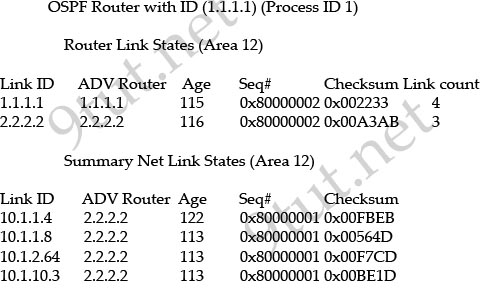
From the output above we can see LSA Type 1 (Router Link State) and LSA Type 3 (Summary Net Link State).
Question 7
[am4show have=’p2;’]Which statement describes the process ID that is used to run OSPF on a router?
A. It is globally significant and is used to represent the AS number.
B. It is locally significant and is used to identify an instance of the OSPF database.
C. It is globally significant and is used to identify OSPF stub areas.
D. It is locally significant and must be the same throughout an area.
Answer: B[/am4show]
Question 8
[am4show have=’p2;’]Refer to the exhibit.
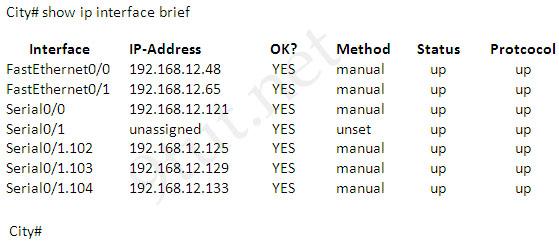
A network associate has configured OSPF with the command:
City(config-router)# network 192.168.12.64 0.0.0.63 area 0
After completing the configuration, the associate discovers that not all the interfaces are participating in OSPF.
Which three of the interfaces shown in the exhibit will participate in OSPF according to this configuration statement? (Choose three)
A. FastEthernet0/0
B. FastEthernet0/1
C. Serial0/0
D. Serial0/1.102
E. Serial0/1.103
F. Serial0/1.104
Answer: B C D[/am4show]
Explanation
The “network 192.168.12.64 0.0.0.63″ equals to network 192.168.12.64/26. This network has:
+ Increment: 64 (/26= 1111 1111.1111 1111.1111 1111.1100 0000)
+ Network address: 192.168.12.64
+ Broadcast address: 192.168.12.127
Therefore all interface in the range of this network will join OSPF -> B C D are correct.
Question 9
[am4show have=’p2;’]What is the default values for hello and dead packets in OSPF?
A. hello 10
B. hello 60
C. dead 40
D. dead 120
Answer: A C[/am4show]


In Q10, why is the maximum hello is 10 and the maximum dead timer is 40? Aren’t those the default parameters?
Question 9 is AFU. First off its an interval not a cost. And I believe they are looking for the default settings for hello/dead, not maximum.
sorry gys, Where are the questions
hello-interval—Represents the length of time between the transmission of hello packets. The value can be from 1 – 65535 seconds. The default is 10 seconds.
Q2. If we imagine that no mistakes were done and the default interface is really s0/0. It will obviously cause the loop, and may affect the neighboring state of the routers…. Then the answer would be: Router R2 will not form a neighbor relationship with R1. Is it possible?
Guys where the questions for this answer because I can found it in the guide put in this page.
Q9 – the answer quoted seems to be the default OSPF timers, but depending on the type of link involved I believe max cost hello is 30s and dead time same is 120s.
But these options do not appear in the question. There has to be a relation of 1:4 hello timer: dead timer according to everything I have seen in OSPF so the only answers which can be correct under the circumstances are A and C. But it is not absolutely correct, just the only possibly correct solution with this set of possibilities.
Are there any OSPF IPv6 questions on current 200-125 or 200-105 exams?
where is the questions
Question 9 doesn’t mean anything, please remove this.
FYI, on Q2, I tested, and the answer should be C. regardless of the default route pointing to s0/0, the routers form FULL ADJ, however R2 does *not* receive the default route. Afterward, when I correctly re-configured it to point to the ISP, R2 updated with *S route of R1
@DL – Are you high?
idiot! go study. stop using braindumps
Q1- I tried various searches on Cisco site and i can’t understand how the subnet is being calculated to get the sub net of 0.0.0.15 as part of the answer
network 10.10.2.16 0.0.0.15 area 0
Any pointers?
@tashi
OSPF command stated The frame relay network is 10.10.2.16/28 off the s0/0 interface split up into /30 for point to point
The /28 wildcard mask is 0.0.0.15 encompassing 10.10.2.17-31 hosts which will fall under area 0
/30 wildcard 0.0.0.3
/29 0.0.0.7
/28 0.0.0.15
And so on it’s just the bit value -1
/24/256/0.0.0.255 the end numbers if you also -1 is the number of valid hosts
/25/128/0.0.0.127
/26/64/0.0.0.63
/27/32/0.0.0.31
/28/16/0.0.0.15
@tashi
I’m hoping to simplify what OSPF said but this may be more confusing. If so I am sorry but I hope it helps someone, anyone nonetheless.
The following subnets in the topology need to be advertised into a single network, a.k.a. the network command “network 10.10.2.16 0.0.0.15 area 0”
Those subnets are:
10.10.2.17/30
10.10.2.21/30
10.10.2.25/30
10.10.2.29/30
Think of it like as if you want to summarizing those 4 subnets into one… then imagine that each subnet has a bit value of 1 in binary, so…
counting from right to left 2, 4, 8, 16, etc.
Since each bit value increments by 2 (Binary) once you hit the 4th bit (for 4 subnets being summarized), you get 16.
The 16 bit is a /28 so now you are summarizing those four subnets into a /28 or the wildcard mask equivalent of 0.0.0.15
10.10.2.16 is the network portion of those summarized subnets because a /28 is a subnet of 255.255.255.240 or…
16 subnets each with 16 host bits – 2 bits for Network and Broadcast, leaving 14 usable hosts for each of our 16 subnets.
Those hosts broken down into: Network (NB) – Usable (UU) Thru Usable (UU) – Broadcast (BB)
NB – UU thru UU – BB
————————
00 – 01 thru 14 – 15
16 – 17 thru 30 – 31 <— The 4 /30 subnets noted above live here. Which is why 10.10.2.16 is the network.
—
32 – 33 thru 46 – 47
Cheers